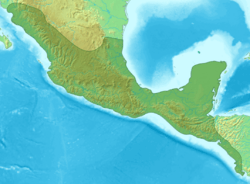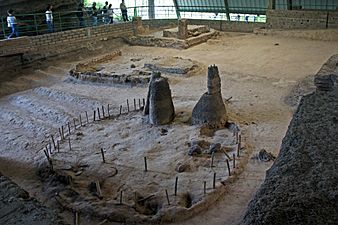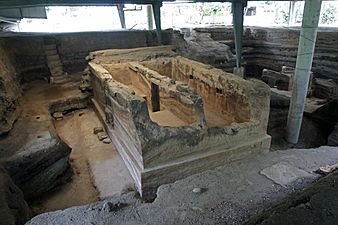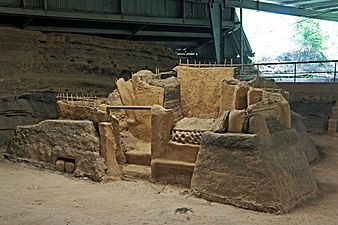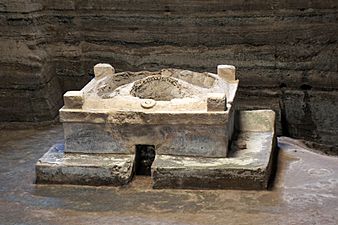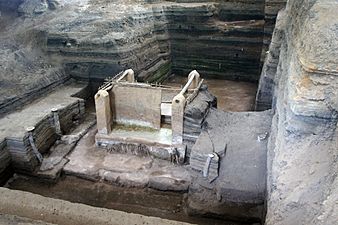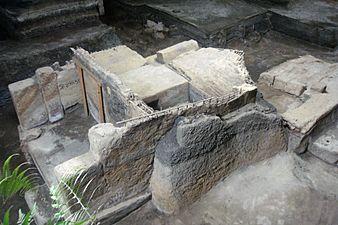Joya de Cerén facts for kids
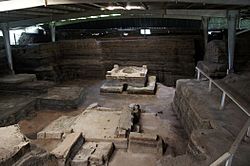
Remains of the Maya village of Joya de Cerén, 2012
|
|
| Location | La Libertad Department, El Salvador |
|---|---|
| Coordinates | 13°49′39″N 89°22′09″W / 13.82750°N 89.36917°W |
| History | |
| Cultures | Maya civilization |
| Official name | Joya de Ceren Archaeological Site |
| Type | Cultural |
| Criteria | iii, iv |
| Designated | 1993 (17th session) |
| Reference no. | 675 |
| Region | Latin America and the Caribbean |
Joya de Cerén (which means Jewel of Cerén in Spanish) is an amazing archaeological site in El Salvador. It was once a farming village of the ancient Maya civilization. This special place is in the La Libertad Department.
Many people call Joya de Cerén the "Pompeii of the Americas". This is because, like the famous Roman city of Pompeii, it was suddenly buried by a volcanic eruption. Around the year AD 600, the Loma Caldera volcano erupted. It covered the village in ash, preserving it almost perfectly.
Archaeologists have found many plant remains here. This helps us learn a lot about the daily lives of ancient Maya farmers. For example, they discovered a field of manioc, which was the first time this crop was found at an ancient site in the Americas. Joya de Cerén was added to the UNESCO World Heritage List in 1993. It's now a popular place for tourists to visit in El Salvador.
Contents
How Joya de Cerén Was Abandoned
About 1,400 years ago, around 200 people lived in the village of Joya de Cerén. The Loma Caldera volcano erupted, burying the entire site under 4 to 8 meters of ash. This happened very quickly, in just a few hours. The ash was not too hot, which helped preserve the village incredibly well.
Archaeologists used a method similar to the one used in Pompeii to make plaster casts. This helped them identify different plants, like fruit trees and corn. They found lots of beans stored away and mature maize (corn). This suggests the eruption happened in August or September.
The villagers grew crops like guava, agave, cacao, and manioc. Scientists believe a small earthquake, about 4.0 on the Richter scale, happened before the eruption. This might have given the people time to escape. Also, steam coming from the volcano could have warned them.
No human remains have ever been found at Joya de Cerén. This suggests that everyone managed to get away safely. Archaeologists think the evacuation happened in the early evening. They found tools like shovels stored near homes and fires lit in hearths. Sleeping mats were not yet rolled out, which also points to an early evening escape.
Exploring the Village Plaza
Joya de Cerén is divided into different areas. Archaeologists have found 18 structures, and they have dug up ten of them. These structures include homes, kitchens, workshops, and even a community sauna.
Structure 10: The Community Hall
Structure 10 is a large building with many rooms and hallways. Archaeologists believe it was used for community festivals and special events. This is because they found items related to ceremonies inside.
For example, decorated pots and a special headdress made of deer and twine were found here. These items might have been used in rituals for good harvests. They also found pots filled with achiote seeds, which suggests a ceremony might have been interrupted by the volcano.
Structure 12: The Diviner's House
Structure 12 is near Structure 10. It has a doorway and two special windows that controlled who could enter. Archaeologists think this building was also used for religious activities.
Inside, they found a collection of items that might have belonged to a woman who told the future. This "tool kit" included ceramic figures, shell pieces, beans, and antlers. It suggests that this building was used for fortune-telling.
Structure 1: A Busy Kitchen
Structure 1 is also known as Household 1. Archaeologists believe its kitchen was very important for the community. They think it was used to prepare food, especially masa (corn dough), for the ceremonies held in Structures 10 and 12.
By looking at how worn the hearths (fireplaces) were, scientists could tell if a building was used for daily cooking or for special events. They found that each household had about 70 pots and vessels for cooking and serving food and drinks.
What the Villagers Traded
The people of Cerén made many things themselves, like agave fibers, grinding stones (manos and metates), and pottery. They also traded for things they couldn't make.
They got sharp cutting tools made from obsidian and chert. They also got beautiful green jade from the north. Fancy pottery from places like Copán might have come from bigger markets. If a household had extra goods, they would trade with other families in the village or nearby areas.
How Joya de Cerén Was Found
Joya de Cerén was discovered by accident in 1976. A bulldozer driver was clearing land for a farming project when he uncovered the first structures. These were Structure 10 and 12.
Payson D. Sheets, a professor from the University of Colorado at Boulder, started exploring the site in 1978. Excavations began again in 1988 and have continued ever since. So far, about 70 buildings have been found. These include homes, kitchens, workshops, and even a communal sauna.
Images for kids
See also
 In Spanish: Joya de Cerén para niños
In Spanish: Joya de Cerén para niños


